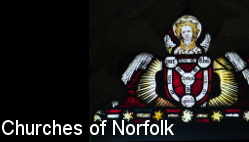| |
Glory to God
in the highest, and on earth peace, goodwill toward men.
So sang the angels on that first Christmas morning, and
images of them, and their message, will appear on a
million Christmas cards, usually in the form of gilded
manuscripts or Renaissance paintings, or lurid females in
the Pre-Raphaelite manner.
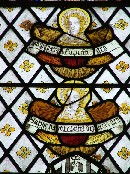 |
|
That
mediaeval manual of church lore The Golden
Legend, put angels firmly in their place, mid-way
between man and God. Man understood that though
angels are our keepers, our ministers, our
brethren and our neighbours, they were also the
bearers of our souls into heaven and representers
of our prayers unto God, right noble knights of
the King of Heaven, who dwell in the royal hall,
accompanying the King of Kings and singing songs
of gladness to his honour and glory. It is no wonder,
then, that angels had such an important place in
the decoration of our mediaeval churches, or
indeed that nearly seven hundred churches in
England were dedicated to St. Michael and All
Angels.
|
| Look
upward at the timber roofs at Knapton, Swaffham
or Cawston in Norfolk,
March in
Cambridgeshire or Woolpit or Blythburgh in Suffolk,
and the angelic host flutters overhead in
its multitudes, 160 figures at Knapton
alone: angels with spread wings on the
wall-plates, angels standing against the
hammer-beams and on the bosses. Their
groupings suggest that the designers,
whoever they were, wished to present a
structure not only of craftsmanship, but
of worship also. The hierarchy of the
angels, Seraphim, Cherubim and Thrones,
Dominions, Virtues and Powers,
Principalities, Archangels and Angels,
dating back to the sixth century and
gleaned from various biblical sources,
including St. Paul’s list of
supernatural beings, is strictly adhered
to, as it is on the screen at Barton Turf.
|
|
|
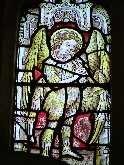 |
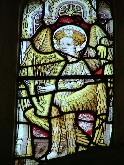 |
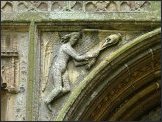 |
|
In
sculpture, some of the most moving carvings are
the flying angels high up on the walls at
Bradford on Avon (Wiltshire), probably carved in
connection with a Saxon Rood which no longer
exists. At Rowlestone, in Herefordshire, four
angels fly upside down supporting the figure of
Christ in Majesty and at Salle, in Norfolk,
feathered figures with censers appear on either
side of the west door.. The feathers have the
appearance of a tightly fitting garment, cut low
around the neck, whilst the sleeves end loosely
above the elbows, and the legs are bare below the
knees. Less well known is the carved angel
orchestra on either side of the Annunciation on
the sumptuous porch at Pulham St. Mary - one side for the
wind and one for the strings. |
Inside the
church angels are everywhere. The wonderful angel
roofs of East Anglia have already been mentioned,
but we find angels adorning fonts, bench-ends,
screens and windows. Often they are shown just
from the waist up, known as demi-angels, and
might support the bowl of an elaborately carved
font, as at Upton, or peer out from
behind the figures of saints, as at Litcham. Sometimes they are
given pride of place to themselves, as above the
main figures adorning the side altars at Ranworth.
Angels occur over and over again in ancient
glass, often carrying inscribed scrolls,
displaying the Te Deum, the Nunc Dimittis or
Gloria in excelsis. In churches dedicated to the
Virgin Mary, Marian antiphons are common: Salve
Regina or Ave Regina caelorum. Some carry
shields, and are often carved on the side of
tombs, but the most common accessory of these
mediaeval angels seems to be musical instruments.
|
|
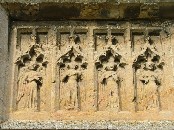 |
|
Paintings,
carving or stained glass, music seems to be
everywhere, and the angelic orchestra contains
the harp, the viol, the organ, the lute (in
various forms,) bagpipes, cymbals, tambours - the
list is endless, and conforms fairly strictly
with Psalm 150: Praise him with the sound of the
trumpet; praise him with the psaltery and harp.
Little remains in situ, but there are excellent
figures at Cawston and Bale, and two particularly well
preserved examples at East Barsham, one playing the
harp and one the cornetto, where the mouthpiece
is carefully depicted. There are countless angels
in sentimental Victorian windows, but the
extraordinary church at Booton has a fine all-girl
orchestra, whilst the angels in the Resurrection
window at Walsoken have a timeless
beauty. |
| There is a
legend that Palestrina composed his Missa Papae
Marcelli under the direct influence of an angelic
host. Improbable, no doubt, but just look up at
the Angel Choir at Lincoln or the vault above the
High Altar at Gloucester, or gaze in amazement at
those hammer-beam roofs in East Anglia and hear
in your mind the chorus of flying angels at the
end of Mahler’s Symphony of a Thousand
or the serene angelic voices which close
Berlioz’s L’enfance du Christ,
music that emanates from Heaven alone, shared
between oneself and one’s maker, and in
doing so you can capture some of the spirit and
imagination of those incredible artists and
craftsmen who lavished such skill on decorating
our churches all those centuries ago. |
|
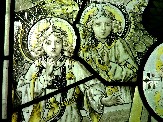 |
Tom Muckley, 1999 rev. 2006
|
|
